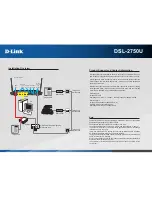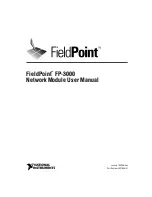
27
Manual
www.kraun.it
• RTS/CTS Threshold:
Should you encounter inconsistent data flow, only minor reduction of the default
value 2347 is recommended. If a network packet is smaller than the preset RTS threshold size, the RTS/CTS
mechanism will not be enabled. The Router sends Request to Send (RTS) frames to a particular receiving
station and negotiates the sending of a data frame. After receiving an RTS, the wireless station responds
with a Clear to Send (CTS) frame to acknowledge the right to begin transmission. In most cases, keep its
default value of 2347.
• Fragmentation Threshold:
This value specifies the maximum size for a packet before data is fragmented
into multiple packets. If you experience a high packet error rate, you may slightly increase the Fragmentation
Threshold. Setting the Fragmentation Threshold too low may result in poor network performance. Only
minor reduction of the default value is recommended. In most cases, it should remain at its default value
of 2346.
• DTIM:
This value, between 1 and 255, indicates the interval of the Delivery Traffic Indication Message
(DTIM). A DTIM field is a countdown field informing clients of the next window for listening to broadcast
and multicast messages. When the Router has buffered broadcast or multicast messages for associated
clients, it sends the next DTIM with a DTIM Interval value. Its clients hear the beacons and awaken to receive
the broadcast and multicast messages. The default value is 1.
• Wireless Mode:
In the drop-down list you can select “802.11b”, “802.11g”, “802.11n”, “802.11b+g”, “802.11g+n”
and “802.11b+g+n”. “802.11b+g+n” allows both 802.11b, 802.11g and 802.11n wireless stations to connect
to the Router.
y
11n Settings:
These are the settings of the 11n parameters. If “802.11n”, “802.11g+n” or “802.11b+g+n” is
selected for
Wireless mode
, these settings will be displayed.
• Channel Bandwidth:
Select the Bandwidth you want to use from the drop-down List. There are two
options, “20 MHz” and “20/40 MHz”. If bigger bandwidth is selected, device could transmit and receive data
with higher speed.
• Extension Channel:
If “20/40 MHz” is selected, this option will be displayed.
• Guard Interval:
Select the guard interval you want from the drop-down list.
• MCS:
Select the wireless transmission rate from the drop-down list.
By default, the option is AUTO.
y
Multiple SSIDs Settings:
These are the settings of the SSID.
• SSID Index:
The index of the SSID, and in this model, you can only leave it as a default value of 1.
• Broadcast SSID:
When wireless clients survey the local area for wireless networks to associate with, they
will detect the SSID broadcast by the Router. To broadcast the Router’s SSID, keep the default setting. If you
don’t want to broadcast the Router’s SSID, select “No”.
• Use WPS:
Use WPS (Wi-Fi Protected Setup) function, you can add a new wireless device to an existing
network quickly. To Use WPS, keep the default setting, and configure the parameters in
WPS Settings
. If
you don’t want to Use WPS, select “No”, then you will see the screen as shown below.
Figure 4-15
• SSID:
Wireless network name shared among all points in a wireless network. The SSID must be identical
for all devices in the wireless network. It is case-sensitive and must not exceed 32 characters (use any of
the characters on the keyboard). Make sure this setting is the same for all stations in your wireless network.
Type the desired SSID in the space provided.
• Authentication Type:
Select an authentication type from the drop-down list, which allows you to configure
security features of the wireless LAN interface. Options available are: Disabled, WEP-64Bits, WEP-128Bits,
WPA-PSK, WPA2-PSK, and WPA-PSK/ WPA2-PSK.
















































